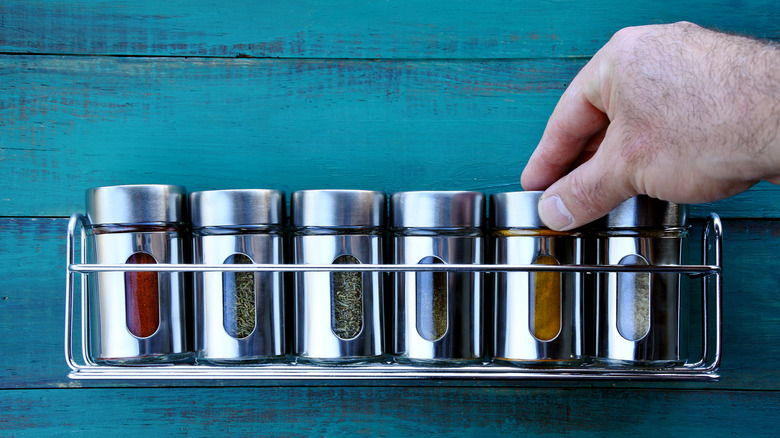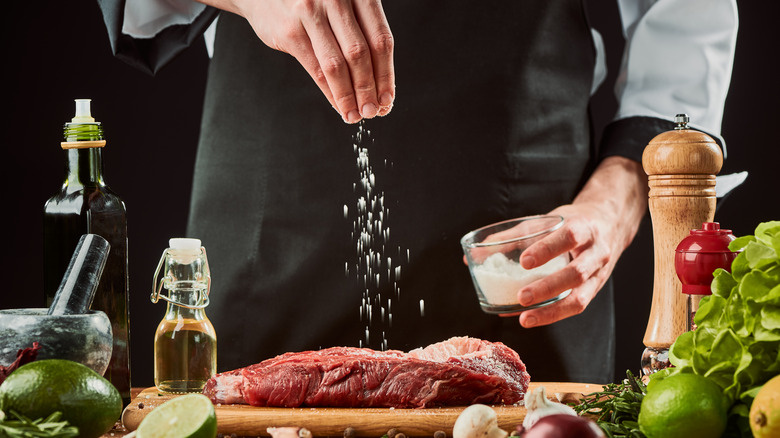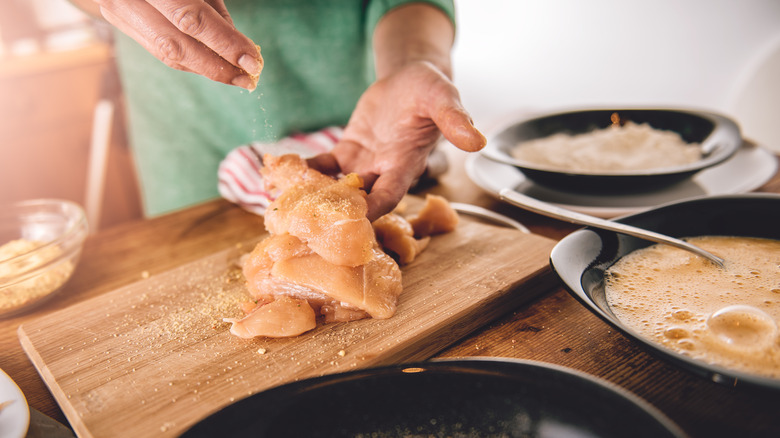Why Seasoning Your Food From Higher Up Makes A Huge Difference
You may have heard the old saying, "meat loves salt." What exactly does this mean? Exactly what it implies. When cooking food, spices and seasoning are key to a flavorful dish. Ask just about anyone who has stepped into a kitchen before and they will likely have their own set of spices they prefer to use throughout their cooking endeavors. Even if you don't consider yourself a master in the kitchen, the use of salt and pepper can literally take a plain piece of meat to one that is flavorful and enjoyable to consume.
Spice is so important that to make it easy to add a little spice to just about any dish, professional chef Rachael Ray has a "24/7 Everyday Seasoning" grinder (via Rachael Ray). So even if you're unsure what you should add to create some good flavors in whatever you're cooking, a little of that should go a long way. But don't think that merely throwing some spices on your dish will do the trick. Seasoning multiple times throughout cooking a dish is also necessary to ensure an even flavor. Also, if you think hovering an inch or two over the dish is okay, it's not. If you want to do it the right way, imagine the classic image of a tough-to-please chef in a professional kitchen throwing a handful of this or that into a dish, often from a high hand. Sure, it looks pretty and all, but there is a method to the high-hand madness.
Seasoning up high helps with flavor distribution
While it may look like chefs are just trying to be fancy when seasoning their food with a hand high above the dish, there is actually a reason for this. According to Cook's Illustrated, sprinkling any form of seasoning from a higher point will allow the seasoning to be more evenly distributed on the food. This is because when you sprinkle from up high, the surface where it will land turns out to be larger, allowing the seasoning to be more evenly distributed (via I'm A Useless Info Junkie). The source quotes Chef Jamie Oliver on the reasoning behind his high hand: "Seasoning from a height gives an even distribution of the seasoning which means you can get the best flavour from your cooking!"
Think about it — if you try to sprinkle a handful of salt on some meat from an inch above it, you have to physically move your hand along the cut of meat to make sure it all gets covered. If you hold your hand several inches above the cut of meat, then the spices get sprinkled over a wider area on the meat. It's not rocket science to see this in action, and it makes a lot of sense.
If you want to do less work when it comes to seasoning, Cook's Illustrated suggests you hold that hand up high and steady and start sprinkling your desired spices from anywhere between 8 to 12 inches above the food.
The higher, the better
If the thought of sprinkling some of your favorite spices onto your prepped food excites you, then you're about to have a field day. Cook's Illustrated actually conducted an experiment where they seasoned various cuts of chicken from different height levels. With photos showing seasoning of the chicken cutlets from four inches, eight inches, and 12 inches, it clearly shows which cut of chicken looks the best seasoned. The piece of chicken seasoned at just four inches above had a narrow line of seasoning, covering only the middle section. The chicken breast seasoned from eight inches above definitely looked better, showing around a 70% spread of spices. Then of course came the results from the chicken seasoned by a whole foot above, which looks like a perfect, even coating of seasoning.
When it comes to seasoning your food, the higher the better is an experiment-proven rule to follow. You could go higher than 12 inches, but just be prepared to miss some of your food and have a little more cleanup afterward.


